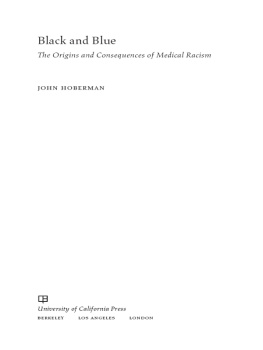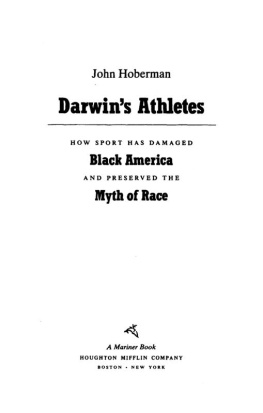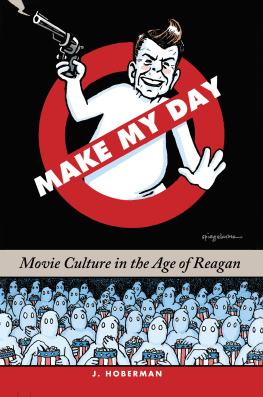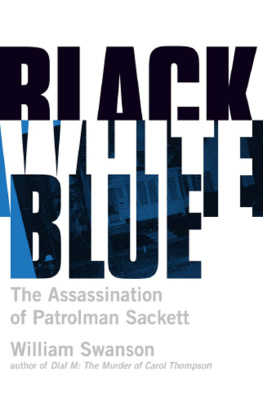Hoberman - Black and Blue
Here you can read online Hoberman - Black and Blue full text of the book (entire story) in english for free. Download pdf and epub, get meaning, cover and reviews about this ebook. publisher: University of California Press, genre: Politics. Description of the work, (preface) as well as reviews are available. Best literature library LitArk.com created for fans of good reading and offers a wide selection of genres:
Romance novel
Science fiction
Adventure
Detective
Science
History
Home and family
Prose
Art
Politics
Computer
Non-fiction
Religion
Business
Children
Humor
Choose a favorite category and find really read worthwhile books. Enjoy immersion in the world of imagination, feel the emotions of the characters or learn something new for yourself, make an fascinating discovery.
Black and Blue: summary, description and annotation
We offer to read an annotation, description, summary or preface (depends on what the author of the book "Black and Blue" wrote himself). If you haven't found the necessary information about the book — write in the comments, we will try to find it.
Hoberman: author's other books
Who wrote Black and Blue? Find out the surname, the name of the author of the book and a list of all author's works by series.
Black and Blue — read online for free the complete book (whole text) full work
Below is the text of the book, divided by pages. System saving the place of the last page read, allows you to conveniently read the book "Black and Blue" online for free, without having to search again every time where you left off. Put a bookmark, and you can go to the page where you finished reading at any time.
Font size:
Interval:
Bookmark:
Acknowledgments
Like any work of research produced over a long period of time, this book has been made possible by the efforts of many people and institutions. Much of the research was done at the Francis A. Countway Library of Medicine at Harvard Medical School, the John Crerar Library at the University of Chicago, and the Life Sciences Library at the University of Texas at Austin. I am grateful to those who have built and maintained these wonderful collections. This work has benefited greatly from years of classroom discussions with the University of Texas students who have taken Race and Medicine in African-American Life since 2001; some of their stories are in the book. Many colleagues, friends, and correspondents have generously contributed to this project by providing information, ideas, invitations, introductions, good conversation, and comments about the manuscript. I would like to offer my special thanks to Rachel Brown Ater, MSW, Carl C. Bell, MD, Deborah Bolnick, PhD, Khiara Bridges, PhD, David Broad, PhD, Robert Eisenberg, MD, Adriane Fugh-Berman, MD, John Hartigan, PhD, Edward Havranek, MD, Crystal Hlaing, MD, David Hoberman, PhD, Eric P. Hoffman, PhD, Michelle Holmes, MD, Joel Howell, MD, PhD, Sherman A. James, PhD, Shannon Jones, III, MPA, Jay Kaufman, PhD, David J. Malebranche, MD, Jonathan Marks, PhD, David Morris, PhD, Thomas Murray, PhD, Robert S. Schell, MD, and John Valentine, PhD.
This book was made possible by Stan Holwitz, former Associate Director of the University of California Press. Stan's belief in the importance of investigating race relations in American medicine never wavered, and I will be forever grateful for his loyalty and support. Following Stan's retirement, Naomi Schneider, Executive Editor for the Social Sciences at UC Press, took on the project and saw it through to completion. I am very grateful for her commitment and tenacity. Thanks also to Stacy Eisenstark, Acquisitions Coordinator; Hannah Love, Associate Editor for Health; and Kate Warne, Managing Editor. Heather McElwain did a fine job as copy editor of the manuscript. I am also grateful to Michael Bohrer- Clancy, Project Manager at Macmillan Publication Services North America, for supervising the final production of the book.
Finally, I thank my wife Louisa for her companionship and her understanding of the research-oriented life. It is a life she has known first hand. During the long years of work on Black and Blue, she inspired me once again by remaking her professional life with a courage and determination I have always admired. It is a pleasure to acknowledge how much she has done on behalf of this book and everything else we are fortunate to have.
1. The Nature of Medical Racism
The Origins and Consequences of Medical Racism
INTRODUCTION
The idea that discredited (and even disgraceful) ideas about racial differences might play a role in medical diagnosis and treatment is a possibility that some doctors find profoundly disturbing. The racially biased treatment of patients would appear to be a grievous violation of medical ethics and a direct threat to the dignity of the profession. Yet, in the course of the last two decades, the medical literature has published hundreds of peer-reviewed studies that point to racially motivated decisions by physicians either to deny appropriate care to black patients or to inflict on them extreme procedures (such as amputations) that many white patients would be spared. For this conscientious physician, medical racism that implied individual culpability was still somehow unreal, a specter to be exorcized rather than a threat to be acknowledged and confronted.
Black and Blue is the first systematic description of how doctors think about racial differences and how this kind of thinking affects the treatment of their patients. While some fine studies of medical racism have appeared, they have not examined the thought processes and behaviors of physicians in any sort of detailed way. In effect, these studies have not seen fit to enter into the physician's private sphere where specific racial fantasies and misinformation distort diagnoses and treatments. Nor have they shown much interest in identifying the specific origins of racially motivated diagnoses and treatments of black patients that have ranged across the entire spectrum of medical sub-disciplines, from cardiology to obstetrics to psychiatry. It is true that American physicians have been major perpetrators of racialist dogma, as a monumental history of American medical racism states.Black and Blue moves beyond such general claims about racially motivated medical behaviors and describes how mainstream medicine devised racial interpretations that have been applied to every organ system of the human body.
The studies to date have occasionally noted but failed to describe the oral traditions that convey medico-racial folklore and persist over generations of medical students and doctors. As we shall see, the physicianauthors who have taken the trouble to write about the racial dimension of medicine confirm that the medical profession has never embarked upon this kind of self-scrutiny in a serious manner. Interestingly, the medical profession's lack of interest in confronting the racial complexes of doctors has created little activism among even the most concerned medical observers beyond ritualized expressions of concern. While these white medical liberals profess to be troubled by this topic, their efforts at raising consciousness have been episodic and have never acquired the political traction that might catalyze a more effective reckoning with the racially motivated and medically harmful behaviors that have been proven beyond a doubt to exist. It is, therefore, no accident that this book-length examination of the racially motivated mental habits and professional mores of doctors is the work of an outsider to the medical profession.
At the same time, I would point out that this history and analysis of medical racism is the work of a grateful outsider. The criticism of the medical profession presented in this book is not motivated by personal dissatisfaction with doctors. On the contrary, physicians have served me well throughout a long life that has included an open-heart surgery that saved me from a debilitating future of congestive heart failure. My father was a physician-scientist, and his commitment to his patients was inspiring. I learned about medical racism in the library while doing research for another book. I was stunned by the overt racism that appeared in medical journals such as the Journal of the American Medical Association or the American Heart Journal during the first half of the twentieth century. So was my father, who received his M.D. in 1946, a man of anti-racist principles, who knew the famous African American physician Charles Drew in Boston before the latter's premature death in 1950. As a Jew who had experienced anti-Semitic insults, my father was aware of the reality of bigotry in American society. But the medical racism of American physicians during his lifetime had somehow passed him by.
AVOIDANCE AND EVASION
The general awkwardness surrounding racial issues in our society bleeds into medicine, the prominent African American cardiologist Clyde Yancy observed in 2009.
Today the great majority of doctors are likely to regard information about medical racism as of little relevance to their professional lives. This is hardly surprising, given that large majorities of white Americans take little or no interest in the special problems their African American fellow citizens experience. There has long been, and there remains, a widespread conviction among whites today that the disadvantages blacks face are of their own making, since formal racial equality was established by the civil rights and voting rights laws and affirmative action initiatives, all of which date from the 1960s. And there is no reason to assume that the racial views of doctors differ in any significant ways from those of the general population.
Next pageFont size:
Interval:
Bookmark:
Similar books «Black and Blue»
Look at similar books to Black and Blue. We have selected literature similar in name and meaning in the hope of providing readers with more options to find new, interesting, not yet read works.
Discussion, reviews of the book Black and Blue and just readers' own opinions. Leave your comments, write what you think about the work, its meaning or the main characters. Specify what exactly you liked and what you didn't like, and why you think so.










